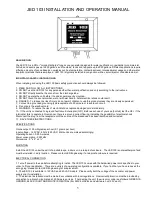
931054C / 1213
6. MENU COMMANDS
45
between
!
1.6 V to +3.0 V (inclusive). Typically, the threshold voltage should be set halfway
between the upper and lower amplitude limits of the signal provided to the Channel Advance
input.
The Acq Mode radio buttons determine how new data is collected.
!
Sum — The current pass data are added to data from previous passes.
!
Replace — The current pass data replace the data from previous passes.
!
Rep/Sum — The first pass replaces any current data, then the remaining passes are
summed.
The Trigger radio buttons determine how passes are started.
!
Internal — The first pass begins immediately when the Start command is issued. When
a pass completes, the next pass starts immediately with no dead time.
!
External — A pass does not start until the appropriate signal is applied to the START
input on the front panel of the MCS. After a pass completes, the MCS unit stops and
waits until another start signal occurs on the START input before beginning the next
pass. See Section 2.1.1 for timing details.
In general, the External trigger is used to synchronize the MCS to the external hardware, while
the external hardware is synchronized to the MCS by selecting the Internal trigger. See
Sections 2.1.1 and 2.1.2.
The current Pass Count Preset and Dwell Time for the selected MCS are shown on the Sidebar.
These values are not affected while you enter the values into the dialog or Cancel the dialog.
They do change, however, as soon as you click OK.
6.2.6. Input Control...
Selecting Input Control... opens the dialog shown in Fig. 31. This command is available in both
buffer and MCS mode, even if the MCS is acquiring data. However, for the MCSs that are
acquiring data and in buffer mode, the settings can’t be changed.
The Use SCA Input and Use Disc Input buttons determine which input is used. When Use SCA
Input is “on” (highlighted), the SCA input is activated. When the Use Disc Input button is
highlighted, the fast discriminator is activated for the BNC connector labeled IN.
The SCA input accepts pulses that fall between two levels. For the signal to be accepted, the
signal must start at a voltage less than the lower level, rise to a voltage that is between the lower
and upper levels, then return to a voltage less than the lower level. The lower and upper levels
Summary of Contents for Easy-MCS
Page 10: ...x...
Page 20: ...Easy MCS Multichannel Scaler and MCS 32 A73 B32 Software 931054C 1213 10 Intentionally blank...
Page 24: ...Easy MCS Multichannel Scaler and MCS 32 A73 B32 Software 931054C 1213 14 Intentionally blank...
Page 77: ...931054C 1213 7 KEYBOARD FUNCTIONS 67 Fig 59 MCS 32 Keyboard and Keypad Accelerators...
Page 98: ...Easy MCS Multichannel Scaler and MCS 32 A73 B32 Software 931054C 1213 88 Intentionally blank...
Page 100: ...Easy MCS Multichannel Scaler and MCS 32 A73 B32 Software 931054C 1213 90 Intentionally blank...
Page 108: ...Easy MCS Multichannel Scaler and MCS 32 A73 B32 Software 931054C 1213 98 Intentionally blank...
Page 110: ...Easy MCS Multichannel Scaler and MCS 32 A73 B32 Software 931054C 1213 100 Intentionally blank...
Page 114: ...Easy MCS Multichannel Scaler and MCS 32 A73 B32 Software 931054C 1213 104 Intentionally blank...
Page 130: ...Easy MCS Multichannel Scaler and MCS 32 A73 B32 Software 931054C 1213 120 Intentionally blank...
















































